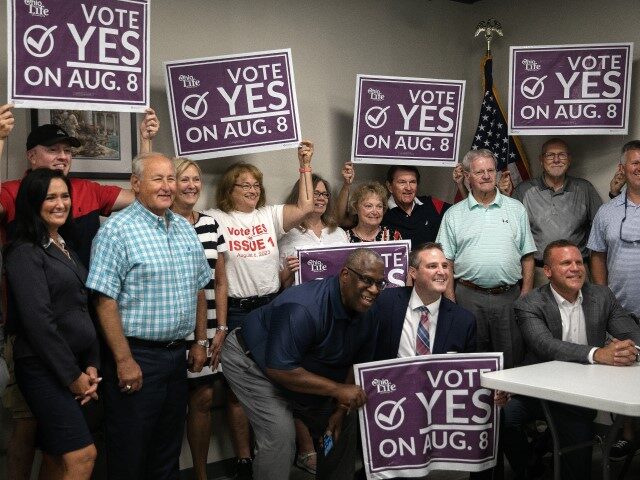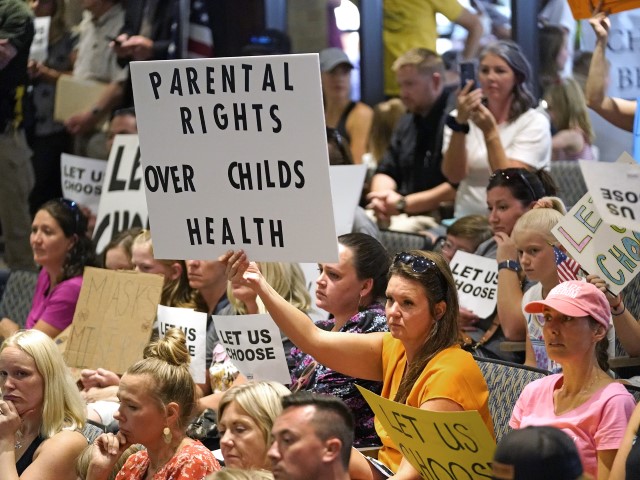The failure of Issue 1 in the Ohio special election August 8 was the result of major messaging issues, combined with millions in funding from left-wing dark money groups, according to one of America’s leading pro-life organizations.
Issue 1, a measure that would have raised the threshold to pass amendments to the state constitution from 50 percent plus one to 60 percent, failed with 57 percent of Ohioans voting “no” and 43 percent voting “yes.” The vote count was substantial, dwarfing other recent special and primary elections with more than three million ballots cast.
While Issue 1 would have impacted many political interests, the amendment was largely viewed as a proxy war over abortion in Ohio. In November, Ohioans will vote on whether to codify a radical abortion ballot measure into the state constitution, and Issue 1’s passage would have complicated left-wing activists’ push for abortion on demand. Groups like the ACLU and Planned Parenthood and its affiliates, which are pushing the abortion ballot measure, waged war against Issue 1 as a result.
Opponents of the abortion ballot initiative are urgently warning that it would decimate parental rights, lead to abortion on demand, and even allow minors to pursue sex-change procedures. Several left-wing coalition members pushing the measure have notably long campaigned to end parental involvement laws.
‘Absence of Communication’
In a press call on Tuesday, Susan B. Anthony Pro-Life America reflected on the Ohio special election and looked ahead to the November abortion battle and beyond. The pro-life organization largely blamed an “absence of communication” from state Republicans and business groups, and said they left an information vacuum during early voting after promising to fund a campaign in favor of Issue 1.
“What happened in Ohio was that there was an absence of communication, from the business and GOP community, at a time where the ballot question had everything to do with a constitutional perspective that went way beyond the life issue, and the only ones that were speaking [were pro-life advocates]. No one was speaking to the other aspects of the constitutional question,” SBA Pro-Life America president Marjorie Dannenfelser said.

Marjorie Dannenfelser, president of the Susan B Anthony List (Astrid Riecken for the Washington Post via Getty Images)
“We got crushed in the early vote,” added SBA Pro-Life America vice president of political affairs Billy Valentine. “The question is, how did that happen?
Valentine assessed:
The other side went up big with millions of dollars of spending right before early voting began on July 11. It was at this point in the campaign in Ohio where the pro-life side — our side — we were being told: “Look, you just focus on mobilizing the pro-life vote in a very targeted way. The business community is going to come in big. They’re going to handle the big media spending. The Ohio GOP is going to handle the overall [get out the vote] and voter mobilization. You just handle your slice of the voters and we’ll take care of the rest.”
Instead, during that critical time period, ahead of the early vote, our side was completely silent on the airwaves.
Additionally, opponents of Issue 1 had a “very pro-democracy message” and “aired only one ad focusing on abortion,” choosing to keep its rallying cry broadly appealing, Valentine said.
“They said Issue 1 is an attack on the voters that would end majority rule in Ohio. It was a broad message; it was a nonpartisan message. It was a populist message,” he said. “We believe that that peeled off a significant chunk of voters who, if we had been communicating, we could have gotten. I think that bears out when you look at the map, where we lost 15 counties that Trump had carried in 2020.”
The pro-life organization said it was able to rally and work together with the pro-parent group Protect Women Ohio to advertise in favor of the amendment.
“Toward the end, we were able to match them on television. We were up on digital, mail, and our army went door to door in the state, reaching 200,000 doors,” he said. “But again, it just was not enough to overcome that early vote and the millions of dollars where the other side got to define the contours of the race.”
In response to SBA Pro-Life America’s outlook on the special election, Ohio GOP spokesman Dan Lusheck told Breitbart News that “[t]he Ohio Republican Party turned out more ‘yes’ votes than anyone expected in this special election.” The Ohio GOP did mobilize thousands of volunteers to rally around Issue 1 and organized voter events and contact efforts.
“We look forward to working with our pro-life partners to defeat the Democrats’ radical abortion amendment in November,” Lusheck added.
Money Matters
Pro-life organizations and proponents were up against much more than disgruntled local Ohio abortion activists fear-mongering about Issue 1. Recent disclosures show that liberal dark money group and their special interest allies led efforts to oppose Issue 1.
Dark money groups like Arabella Advisors’ Sixteen Thirty Fund and the ACLU were some of the biggest donors supporting the opposition to Issue 1. According to recent disclosures, Arabella’s network of dark money groups has poured $3.65 million into opposing Issue 1. The Sixteen Thirty Fund contributed $2.5 million to the Issue 1 opposition, the Hopewell Fund contributed $650,000, and North Fund contributed $500,000. Issue 1 opponents also received nearly $1.9 million from the Tides Foundation, another left-wing dark money group with close ties to Arabella.
The Catholic News Agency reported:
The “no” campaign, however, spent about three times the amount of money the “yes” campaign did. The campaign against Issue 1 spent nearly $15 million to discourage Ohioans from supporting the initiative, about 85 percent of which came from outside the state. A large portion of this money was funneled through the Sixteen Thirty Fund and the Tides Foundation, which allow donors to provide funding to left-wing causes without publicly disclosing the donations.
The vast majority of the funding for the Issue 1 opposition came from outside of Ohio, with much of the funding coming from Washington DC, California, and New York. Four out of the top five donors to the Issue 1 opposition were from outside of Ohio.
Out of the top ten groups contributing to the Issue 1 opposition, eight were from outside of Ohio (two from California, five from the D.C. area, and one from New York). Over $10 million of the funds raised by the Issue 1 opposition came from left-wing groups in the Washington, DC, area, California, or New York. Over $6.6 million came from the D.C. area, nearly $3 million from California, and $650,000 from New York, disclosures show.
“That’s something that we’ve seen in all these ballot initiative fights since last cycle: our side continues to get out-raised and out-spent by the other side,” Valentine said. “That, matched with the energy post-Dobbs, is hard and it’s tough. But we know we have a winning message. We have to have the resources behind it and get it out early.”
Valentine said next time, the pro-life movement must “go on offense” and “be the first one up on the airwaves.”
“You have to define what the race is,” he said, adding that SBA Pro-Life America looks to broaden its message about the abortion ballot initiative moving forward to focus also on its potential impact on parental rights.
Dannenfelser added that activists in Ohio should “do exactly what [they’ve] been doing and do more of it” and said, encouraged, that Issue 1’s failure does not constitute “a referendum on abortion.”
Copy and Paste
The pro-life movement will have plenty of other opportunities outside of Ohio to go on offense, as the pro-abortion lobby is intent on copying and pasting its ballot initiative efforts in other vulnerable states.
Local affiliates of the same pro-abortion groups pushing the Ohio amendment, like Planned Parenthood and the ACLU, are launching similar abortion ballot initiative efforts in Florida, Arizona, Missouri, and South Dakota, and are eyeballing Arkansas, Nebraska, North Dakota, Oklahoma, and Montana.
“It’s anything but a grassroots effort,” Valentine said. “This is a national coordinated strategy to pick off states, red states, that we picked up post-Dobbs.”
“You look at who’s funding these [initiatives], it’s the ACLU, it’s Planned Parenthood, it’s Soros. It’s big, big money flowing in through the states,” he added. “This is a national coordinated effort. There are more [initiatives] that are going to come online — we’re tracking all of them. We’re building up those coalitions in every state and doing our best to try to raise the money necessary to combat them.”
Katherine Hamilton is a political reporter for Breitbart News. You can follow her on Twitter @thekat_hamilton.


COMMENTS
Please let us know if you're having issues with commenting.